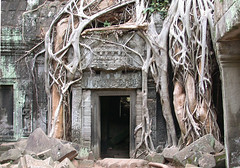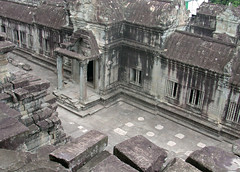
SIEM REAP, Cambodia – A Cambodian teenager guiding an elephant motions
for the animal to stop under a tree.
The boy straddling the elephant's neck plucks leaves from a branch and
places them between his lips, producing a reed instrument to entertain
the American tourists he is leading. The elephant ride is a majestic arrival to the ancient Angkor
temples worthy of the Hindu kings who ruled this mythical temple city
from the 9th to the 15th century.
"There are over 100 temples. Most are dedicated to Hinduists," said Sar
Kunthy, an English-speaking guide at the "Lost City" in Northwestern
Cambodia.
After being ignored and neglected for decades, the ancient city is
gaining broad attention from across the globe now that Cambodia is
enjoying peaceful times.

It had not been safe to visit this region of Southeast Asia since
before the Vietnam War because of land mines and civil strife.
Cambodia's Khmer Rouge regime also looted the temples, and its guerilla
fighters used nearby jungles as hiding places until the early 1990s.
Cambodia's monarchy had returned to power by the time the regime's
leader, Pol Pot, died in 1998, bringing an end to one of the bloodiest
chapters in the country's history.
In 2004, the palaces and temples were removed from the United Nations
Educational, Scientific and Cultural Organization's most endangered
ancient sites list because millions of dollars had been spent to restore
the former Khmer Empire capital city. It was a monumental task just
removing the land mines, as well as jungle roots and vines that covered the crumbling,
sandstone buildings.

Archaeologists from several countries, including Australia and France,
have been putting the temples back together and studying the many
bas-reliefs and intricate irrigation system that served the more than
one million people who once lived here. The temples, some built to
honor Buddha, are situated across 248 square miles, making up one of
the largest archaeological sites in the world.
There are many mysteries to be solved and unknown sites for researchers
to discover and explore.
"They recently found a 2,000-year-old tomb," Kunthy said. "There are
still underground temples yet to be found. So far, we have not been
able to find the tool used to cut the stone."
The most famous temple, Angkor Wat, was constructed over three decades
in the 12th century during the reign of King Suryavarman II. It took
50,000 workers 37 years to build the world's largest religious
building. It stands nearly 190 feet tall and is reached by a walkway
crossing a nearly 600-foot moat.
The entrance to Angkor Wat is flanked by giant sandstone sculptures of
serpents representing fertility. Crocodiles, according to legend, once
lurked in the water to protect the city from invaders, Kunthy said.
Inside, visitors pass the world's largest bas-reliefs telling the
stories of Hindu mythology. Some of the intricate and beautiful
sculptures pay tribute to the Hindu god, Vishnu, whose four arms, mercy
and power preserved the universe and ensured cosmic order.
Organized tours also offer visitors a taste of deep-fried crickets sold
at roadside huts. Villagers string light bulbs over small plastic ponds
to catch the insects, that when fried, taste like cashew nuts, the tour
driver says.

Children by the hundreds pressure tourists to buy postcards, small
flutes made from bamboo or Tro Us, the traditional Khmer string
instrument made with a coconut shell covered with snakeskin. Their
sales pitch requires them to memorize and recite the capitals of each
of the 50 states to impress American travelers. A Cambodian police
officer, meanwhile, follows a crowd trying to sell his police badge
that looks like a cheap, plastic replica of the one he is wearing.
A band made of up musicians with missing limbs or eyes – land mine
victims – performs outside one temple where the jungle has not been
stripped away. The temple, Ta Prohm, can be seen as a backdrop in
Angelina Jolie's 2001 adventure movie, "Lara Croft: Tomb Raider."
Every family in Cambodia has at least one member who was either killed
or injured by land mines placed by Pol Pot's army or the Viet Cong,
Kunthy said.
"There are up to 200,000 people with land-mine injuries," he said.
Angkor is drawing more than a million visitor, Kunthy
said, creating the need for the rows of new luxury resorts in Siem
Reap.
(One day is not enough to see or appreciate Angkor, an hourlong flight
from Ho Chi Minh City, Vietnam.)

No comments:
Post a Comment